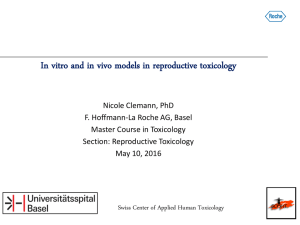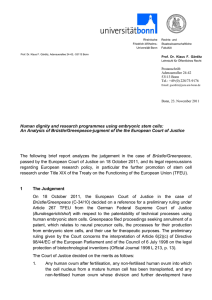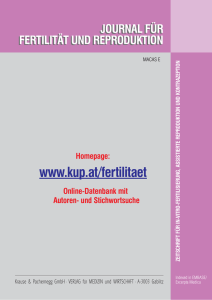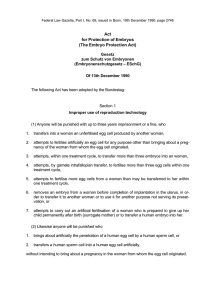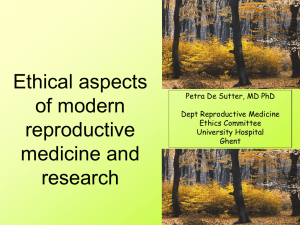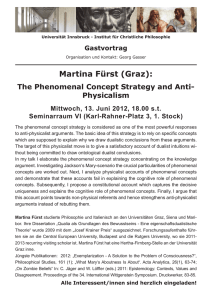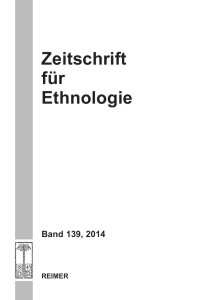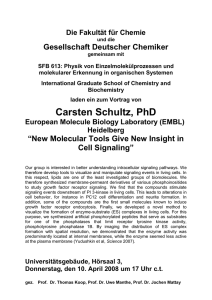The Legal Status of the Human Embryo in vitro
Werbung
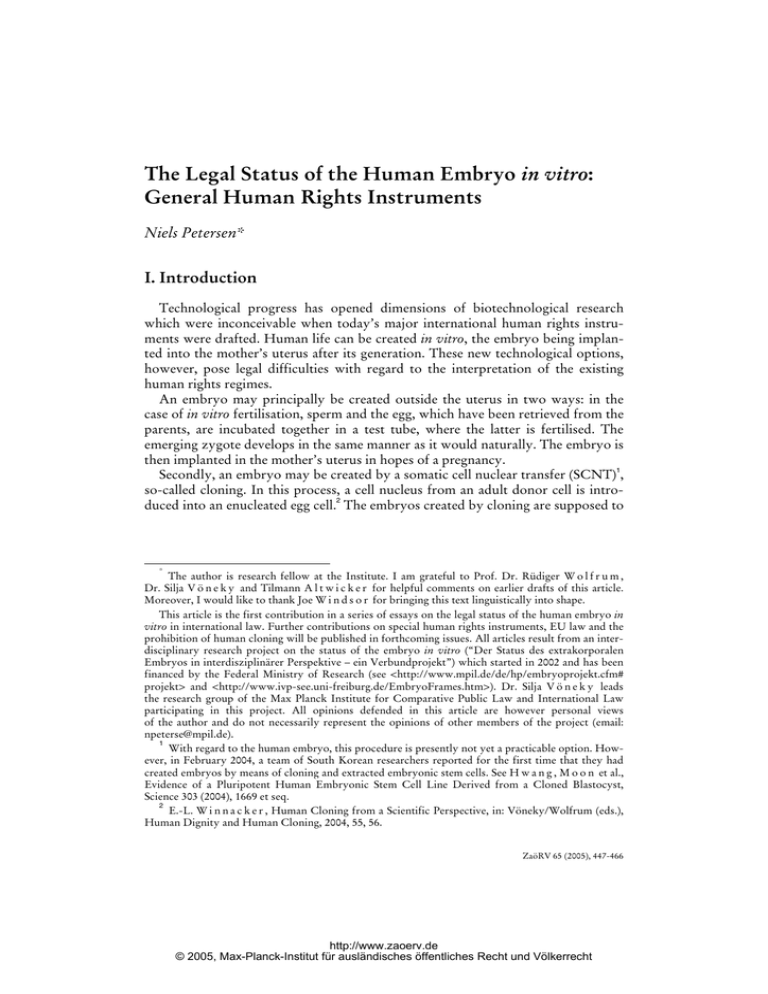
The Legal Status of the Human Embryo in vitro: General Human Rights Instruments Niels Petersen* I. Introduction Technological progress has opened dimensions of biotechnological research which were inconceivable when today’s major international human rights instruments were drafted. Human life can be created in vitro, the embryo being implanted into the mother’s uterus after its generation. These new technological options, however, pose legal difficulties with regard to the interpretation of the existing human rights regimes. An embryo may principally be created outside the uterus in two ways: in the case of in vitro fertilisation, sperm and the egg, which have been retrieved from the parents, are incubated together in a test tube, where the latter is fertilised. The emerging zygote develops in the same manner as it would naturally. The embryo is then implanted in the mother’s uterus in hopes of a pregnancy. 1 Secondly, an embryo may be created by a somatic cell nuclear transfer (SCNT) , so-called cloning. In this process, a cell nucleus from an adult donor cell is intro2 duced into an enucleated egg cell. The embryos created by cloning are supposed to * The author is research fellow at the Institute. I am grateful to Prof. Dr. Rüdiger W o l f r u m , Dr. Silja V ö n e k y and Tilmann A l t w i c k e r for helpful comments on earlier drafts of this article. Moreover, I would like to thank Joe W i n d s o r for bringing this text linguistically into shape. This article is the first contribution in a series of essays on the legal status of the human embryo in vitro in international law. Further contributions on special human rights instruments, EU law and the prohibition of human cloning will be published in forthcoming issues. All articles result from an interdisciplinary research project on the status of the embryo in vitro (“Der Status des extrakorporalen Embryos in interdisziplinärer Perspektive – ein Verbundprojekt”) which started in 2002 and has been financed by the Federal Ministry of Research (see <http://www.mpil.de/de/hp/embryoprojekt.cfm# projekt> and <http://www.ivp-see.uni-freiburg.de/EmbryoFrames.htm>). Dr. Silja V ö n e k y leads the research group of the Max Planck Institute for Comparative Public Law and International Law participating in this project. All opinions defended in this article are however personal views of the author and do not necessarily represent the opinions of other members of the project (email: [email protected]). 1 With regard to the human embryo, this procedure is presently not yet a practicable option. However, in February 2004, a team of South Korean researchers reported for the first time that they had created embryos by means of cloning and extracted embryonic stem cells. See H w a n g , M o o n et al., Evidence of a Pluripotent Human Embryonic Stem Cell Line Derived from a Cloned Blastocyst, Science 303 (2004), 1669 et seq. 2 E.-L. W i n n a c k e r , Human Cloning from a Scientific Perspective, in: Vöneky/Wolfrum (eds.), Human Dignity and Human Cloning, 2004, 55, 56. ZaöRV 65 (2005), 447-466 http://www.zaoerv.de © 2005, Max-Planck-Institut für ausländisches öffentliches Recht und Völkerrecht 448 Petersen be used for the extraction of embryonic stem cells (ES cells), which may serve for 3 research purposes. However, creation and utilisation of embryos in vitro pose difficulties in legal and in ethical respects. If embryos are used for the extraction of embryonic stem 4 cells, they have to be destroyed and therefore lose their potentiality to develop into a human being. Furthermore, the technique of in vitro fertilisation allows a preimplantation genetic diagnosis (PGD), a diagnostic procedure which is per5 formed in order to test the embryo for genetic diseases before implantation. Embryos with identified genetic diseases are not implanted into the uterus and therefore have no opportunity to develop any further. These procedures raise the question whether there are any restrictions on such a utilisation of embryos under public international law. In the course of this analysis, we will concentrate on whether and how the embryo in vitro is protected under general human rights instruments. The analysis will be carried out in two steps: firstly, a general normative standard of protection will be elaborated (II.) and then, secondly, applied to the most debated practical issues in relation to the embryo in vitro, such as PGD and scientific research with embryonic stem cells (III.). II. Normative Standards Considering the protection of the embryo in vitro under general human rights law, primarily two principles are discussed. There is, on the one hand, the right to life (1.) as ensured by several universal and regional human rights treaties. On the other hand, one has to take into account the debate on the existence and scope of a guarantee of human dignity under international law (2.). 1. Protection of Human Life a. Covenant on Civil and Political Rights The main standard for the protection of human life in general international law 6 is Art. 6 of the Covenant on Civil and Political Rights (CCPR). In its first paragraph the norm prescribes that “every human being has the inherent right to life”. However, the wording of the norm does not define the term “human being”. 3 With regard to the advantages of using cloned ES cells in comparison to ES cells extracted from in vitro fertilisation, see ibid., 58. 4 German Research Foundation (ed.), Research with Human Embryonic Stem Cells, 2003, 80. 5 For technical details see W. L i s s e n s /K. S e r m o n , Preimplantation Genetic Diagnosis: Current Status and New Developments, Human Reproduction 12 (1997), 1756 et seq. 6 International Covenant for Civil and Political Rights, adopted on 19 December 1966, reprinted in: UNTS 999, 171. ZaöRV 65 (2005) http://www.zaoerv.de © 2005, Max-Planck-Institut für ausländisches öffentliches Recht und Völkerrecht The Legal Statutes of the Human Embryo in vitro: General Human Rights Instruments 449 Whether the embryo generated in vitro is covered by this provision depends on whether such an embryo can be conceived of as a human being. aa. Full Protection of the Embryo Some authors argue that biological research has revealed that human life begins with the moment of conception. In order to achieve a maximum protection of hu7 man rights, the scope of Art. 6 CCPR therefore has to include unborn life. As any differentiation after the moment of conception would be arbitrary, all forms of human life, the born as well as the unborn, have to be covered by the same level of 8 protection. Such an interpretation would, however, have far reaching consequences – in particular with regard to the admissibility of liberal legislation on abortion. As Art. 6 CCPR contains a clawback clause, according to which the right to life may be restrained if the restriction is not arbitrary, the provision does not guarantee an abso9 lute right to life. But the said clawback clause alludes to the rule of law, of which the principle of proportionality is one major element. Therefore, an intentional deprivation of life is only allowed if it is proportional and equivalent. One can hardly conceive of an equivalent purpose other than the protection of human life which 10 could empower state authorities to deprive a person of his or her own life. If this standard were transferred to all forms of unborn life, not only would research with embryonic stem cells infringe upon Art. 6 CCPR, but the legality of liberal aborti laws would also be highly debatable. Therefore, by extending the protection of Art. 6 CCPR in an equivalent manner to unborn life from the moment of conception, a broad meaning would be ascribed to the term human being. Such an interpretation is however not compulsive. Ex11 pressions have no inherent meaning, but are representative of reality. Consequently, they have to be interpreted in the context of their application. This context is created by those who use language as means of communication. International treaties are drafted by representatives of the states participating in the negotiations. Consequently, the states principally have the power to define the terms 7 T. D e s c h , The Concept and Dimensions of the Right to Life (as defined in International Standards and in International and Comparative Jurisprudence), ÖZÖR 36 (1985), 77, 96. 8 With respect to this line of argumentation see in general C. S t a r c k , The Human Embryo is a Person and not an Object, in: Vöneky/Wolfrum, op. cit. (note 2), 63, 65; E. S c h o c k e n h o f f , Zum moralischen und ontologischen Status des Embryos, in: Damschen/Schönecker (eds.), Der moralische Status menschlicher Embryonen, 2002, 11, 28; E.-W. B ö c k e n f ö r d e , Menschenwürde als normatives Prinzip, JZ (2003), 809, 812. 9 A. R e d e l b a c h , Protection of the Right to Life by Law and by Other Means, in: Ramcharan (ed.), The Right to Life in International Law, 1985, 182, 189. 10 D e s c h , supra note 7, 107; C.K. B o y l e , The Concept of Arbitrary Deprivation of Life, in: Ramcharan, op. cit. (note 9), 221, 241. An exception is the admissibility of the death penalty, which is expressly prescribed in Art. 6 (6) CCPR. 11 S. B e a u l a c , The Power of Language in the Making of International Law, 2004, 8. ZaöRV 65 (2005) http://www.zaoerv.de © 2005, Max-Planck-Institut für ausländisches öffentliches Recht und Völkerrecht 450 Petersen 12 used in international legal instruments. According to Art. 32 of the Vienna Con13 vention on the Law of Treaties (VCLT) , the interpretation may thus be based on the travaux préparatoires if the objective methods mentioned in Art. 31 VCLT fail to clarify the meaning of a term. While elaborating the CCPR, a group of five states, including Belgium, Brazil, El Salvador, Mexico and Morocco, proposed formulating Art. 6 in such a way that 14 human life is protected from the moment of conception. However, this proposal has been rejected by the majority of states. They argued that it would be scientifi15 cally impossible to exactly determine the moment of conception. Even more im16 portant may have been the existence of differences in internal legislations: some states having liberal regulations on abortion feared – not without reason – that these might be incompatible with a broad protection of human life. Therefore, the travaux préparatoires reveal that an equal protection of born and unborn life has 17 not been intended. bb. Gradual Protection of Unborn Life (1) Systematics of Art. 6 CCPR But, although unborn life does not enjoy the same level of protection under Art. 6 CCPR as born human beings, the reference to the travaux préparatoires does not discard the possibility of a gradual protection of unborn life under Art. 6 (1) CCPR. In fact, Art. 6 (5) CCPR stipulates that a “sentence of death ... shall not be carried out on pregnant women”. As there is no reason to privilege the interests of a woman just because of her pregnancy, this provision aims to protect the foetus. Therefore, a certain, gradual level of protection is implicitly also conceded to un18 born life. Point of departure for a differentiation in the level of protection in the wording of Art. 6 CCPR is the clawback clause. As it appeals to elements of equivalence 12 th Cf. Q.D. N g u y e n /P. D a i l l e r /A. P e l l e t , Droit international public, 7 ed., 2002, no. 168. Vienna Convention on the Law of Treaties, adopted on 23 May 1969, reprinted in: ILM 8 (1969), 679. 14 UN Doc. A/C.3/L.654. 15 B.G. R a m c h a r a n , The Concept and Dimensions of the Right to Life, in: id., op. cit. (note 9), 1, 51 16 R e d e l b a c h , supra note 9, 198. 17 Y. D i n s t e i n , Right to Life, Physical Integrity, and Liberty, in: Henkin (ed.), The International Bill of Rights, 1981, 114, 122; M. N o w a k , CCPR Commentary, 1993, Art. 6, para. 35; M.K. E r i k s s o n , The Legal Position of the Unborn Child in International Law, GYIL 36 (1993), 86, 104; H. H a ß m a n n , Embryonenschutz im Spannungsfeld internationaler Menschenrechte, staatlicher Grundrechte und nationaler Regelungsmodelle zur Embryonenforschung, 2003, 28. 18 Likewise W. P e u k e r t , Human Rights in International Law and the Protection of Unborn Human Beings, in: Matscher/Petzold (eds.), Protecting Human Rights: The European Dimension. Studies in Honour of Gérard J. Wiarda, 1988, 511; G. C o h e n - J o n a t h a n , La convention européenne des droits de l’homme, 1989, 281. 13 ZaöRV 65 (2005) http://www.zaoerv.de © 2005, Max-Planck-Institut für ausländisches öffentliches Recht und Völkerrecht The Legal Statutes of the Human Embryo in vitro: General Human Rights Instruments 451 and proportionality, the wording allows a certain flexibility with regard to the means for which the killing of “human life” may be permitted. If unborn life enjoys only gradual protection, a greater range of purposes has to be accepted than just the protection of human life. But where does this protection start and how far does it reach? Does it also cover the embryo in vitro? According to the wording of Art. 6 (1) CCPR the right to life is an i n h e r e n t human right. The term “inherent” expresses the conviction of the state parties that Art. 6 (1) CCPR only codifies an already existing, pre19 positive right and therefore alludes to moral values and natural law. It can therefore not be interpreted in an isolated manner, by simply referring to the wording and genesis of a norm. On the contrary, by using an indeterminate terminology and the allusion to extralegal elements the authors in the drafting process have delegated the concretisation to a certain extent to the underlying ethical discourse, 20 which has consequently to be taken into account by the legal discussion. Ethical considerations shall therefore guide the following attempt of concretisation. However, one has to be aware of the dangers of introducing moral arguments into the legal discourse. Ethical decisions can seldom if ever be derived from gen21 eral principles by purely logical reasoning; they are to a great extent influenced by 22 personal evaluations. The result, therefore, also depends on the person taking the decision. Consequently, the legitimacy of a decision cannot solely be based on the apparent argumentative power of persuasion. Rather, procedural legitimacy is needed, in order to ensure the quality of the moral decision by institutional 23 means. Such procedural legitimacy may be derived from the scientific discourse. This presupposes, however, that a prevailing tendency can be identified. If such a prevalent tendency does not exist, a certain interpretation of a legal norm may not be 24 predetermined by ethical argumentation. The decision has rather to be taken in the political process. Consequently, if the ethical discussion is undecided, the provision has to be interpreted rather restrictively in order not to predetermine the process of political 25 decision-making. Otherwise, political decisions would be bound by non-compulsive legal interpretations. As, however, the political process is the legitimate origin of ethically relevant rules, such a procedure would lack the necessary legitimacy. 19 R e d e l b a c h , supra note 9, 184. Cf. D. v . d . P f o r d t e n , Was ist und wozu Rechtsphilosophie?, JZ (2004), 157, 163. 21 D. S o l t e r et al., Embryo Research in Pluralistic Europe, 2003, 232 et seq. 22 A. T s c h e n t s c h e r , Prozedurale Theorien der Gerechtigkeit, 2000, 267. 23 See N. P e t e r s e n , Europäische Verfassung und europäische Legitimität, HJIL 64 (2004), 429, 456 and 461. 24 Cf. S o l t e r et al., supra note 21, 234. 25 Cf. also A. B l e c k m a n n , Grundprobleme und Methoden des Völkerrechts, 1982, 91, who is generally reluctant with regard to the deduction of concrete norms from general principles. 20 ZaöRV 65 (2005) http://www.zaoerv.de © 2005, Max-Planck-Institut für ausländisches öffentliches Recht und Völkerrecht 452 Petersen (2) The Embryo in vitro as Member of the Human Species There is no doubt that the human embryo, including the embryo generated in vitro, belongs to the human species. Therefore, some philosophers and legal scholars argue that the embryo as member of the human species should be the subject of 26 a right to life (species argument). However, mere biological facts alone do not 27 permit the drawing of normative consequences. A human being is not protected by human rights simply because it is a human being. Such an argumentation would be tautological because it would not explain why humans should altogether be 28 subject to a human rights protection. The reason for attributing human rights, such as the right of life, to human beings is rather due to the fact that humans possess certain characteristics and abilities, such as consciousness or reason. That does not mean that human beings who are not gifted with these characteristics are not worthy of protection by human rights. However, to justify their protection needs special reasoning and cannot simply be based on the mere fact of belonging to a certain species. Being aware of the danger of a naturalistic fallacy, the supporters of the species argument do not solely rely on the fact that embryos belong to the human species in their argumentation. In order to show why embryos deserve protection, they have to leave their purely naturalistic standpoint and make use of continuity and 29 potentiality aspects, arguing that the embryo has to be protected because of its potential to become a human being with the described attributes. Therefore, the sole fact of belonging to the human species does not confer any right to be protected as a human to the embryo. (3) Potentiality and Individuality of the Embryo in vitro Another argument to qualify the embryo as a worthy subject of the general protection of human life recurs to the potentiality of the embryo to become a human 30 being. According to this line of argumentation an embryo deserves protection because it has the potential to develop into a human being in a continuous process. However, potentiality requires a certain probability for the embryo to develop into a human being. Potentiality therefore is the natural course of development 26 R. S p a e m a n n , Christianity and Western Philosophy, in: Vöneky/Wolfrum, op. cit. (note 2), 47, 48 et seq.; S c h o c k e n h o f f , supra note 8, 27 et seq.; implicitly also D e s c h , supra note 7, 96. 27 R. M e r k e l , Zum normativen Status des Embryos und zum Schutz der Ethik gegen ihre biologistische Degradierung, in: Damschen/Schönecker, op. cit. (note 8), 35, 37; C.F. G e t h m a n n , Ethische Anmerkungen zur Diskussion um den moralischen Status des menschlichen Embryos, DRiZ (2002), 204, 206; T. H ö r n l e , Menschenwürde und Lebensschutz, ARSP 89 (2003), 318, 335 et seq. 28 G e t h m a n n , ibid. 29 Exemplary is the line of argumentation of S c h o c k e n h o f f (supra note 8, at 26), who stresses the p r o c e s s of the unborn life to develop as human being (continuity argument) and its p o t e n t i a l for development (Entwicklungspotential, potentiality argument). 30 See W. W i e l a n d , Moralfähigkeit als Grundlage von Würde und Lebensschutz, in: Damschen/Schönecker, op. cit. (note 8), 149 et seq. ZaöRV 65 (2005) http://www.zaoerv.de © 2005, Max-Planck-Institut für ausländisches öffentliches Recht und Völkerrecht The Legal Statutes of the Human Embryo in vitro: General Human Rights Instruments 453 31 without external interference. But the embryo is yet not able to develop outside the mother’s womb. As the embryo in vitro is per definition created artificially, it cannot survive without being implanted into the mother’s uterus. It is therefore dependent on external interference in order to become a human being and there32 fore lacks the potential for independent development. Consequently, the potentiality argument, too, cannot justify why the life of the embryo in vitro should be 33 protected. Some argue that after conception the individual gene of the prospective human being is already predetermined. Because of its individuality, the embryo should 34 therefore enjoy protection of its life. Even if one agrees that the individuality of a human creature is a sufficient reason for protection, this protection cannot start be35 fore nidation. For until nidation the development of multiples is still possible. Even after nidation, it is conceivable that there are different individuals with the 36 same genetic code, as is the case with multiples. Therefore individuality of a human being is a social rather than a biological phenomenon and consequently not suitable to answer the normative question of when the protection of human life should start. (4) Conclusion Consequently, there are no compulsive ethical arguments for why the right to life should also cover the embryo in vitro. This is not meant to deny that there may be good reasons to offer some legal protection also for the embryo outside the mother’s uterus. However, as long as there is an open ethical debate, the question should not be predetermined by the legal discourse. On the contrary, the decision 37 of ethical questions needs the legitimacy of political procedures. Therefore, the protection of the embryo in vitro cannot merely be based on the general protection of the right to life by Art. 6 CCPR, but would need special regulations. 31 L. S i e p , Kriterien und Argumenttypen im Streit um die Embryonenforschung in Europa, in: Jahrbuch für Wissenschaft und Ethik 7 (2002), 179, 187. 32 R. W o l f r u m , Forschung an humanen Stammzellen: ethische und juristische Grenzen, Aus Politik und Zeitgeschichte B 27/2001, 3, 4; H.-G. K o c h , Vom Embryonenschutzgesetz zum Stammzellgesetz: Überlegungen zum Status des Embryos in vitro aus rechtlicher und rechtsvergleichender Sicht, in: Maio/Just (eds.), Die Forschung an embryonalen Stammzellen in ethischer und rechtlicher Perspektive, 2003, 97, 104. 33 M. A n d e r h e i d e n , “Leben” im Grundgesetz, KritV 84 (2001), 353, 378 et seq. 34 R. E n s k a t , Auch menschliche Embryonen sind jederzeit Menschen, in: Damschen/Schönecker, op. cit. (note 8), 101 et seq.; P. K i r c h h o f , Genforschung und die Freiheit der Wissenschaft, in: Höffe/Honnefelder/Isensee/Kirchhof (eds.), Gentechnik und Menschenwürde (2002), 9, 21. 35 S i e p , supra note 31, 185. 36 P. H u c k l e n b r o i c h , Individuation, Kontinuität und Potenzial – Zum Paradigmenstreit in der Theorie der Reproduktion, in: Siep/Quante (eds.), Der Umgang mit dem beginnenden menschlichen Leben, 2003, 37, 54. 37 See supra II 1 a bb (2). ZaöRV 65 (2005) http://www.zaoerv.de © 2005, Max-Planck-Institut für ausländisches öffentliches Recht und Völkerrecht 454 Petersen b. Convention on the Rights of the Child 38 According to Art. 6 (1) of the Convention on the Rights of the Child , every child has a right to life. The term “child” is defined in Art. 1 as every human being below the age of 18. Whether the unborn life is also comprised by this definition is not expressly stated. A hint for the proper interpretation might be found in para. 9 of the preamble, which prescribes that the child needs “special safeguards and care, 39 ... before as well as after birth” . As, according to Art. 31 (2) VCLT, the preamble 40 is one important element of contextual interpretation, one might argue that the provision of the preamble extends the scope of protection also to all forms of hu41 man life before birth. However, the preamble can only be used as auxiliary for contextual interpretation; it cannot considerably extend the ordinary or natural meaning of a legal 42 term. The ordinary definition of the term “child”, however, does not include life before birth. During the drafting process, there was moreover no consensus on the question, whether the definition of the term “child” in Art. 1 should also comprise 43 life before birth. The compromise was to mention the protection of the unborn life in the preamble while leaving intentionally open this question in the definition 44 of Art. 1. Therefore, the travaux préparatoires reveal that the unborn life is not included in the scope of Art. 1 due to the lack of consensus on this question. c. Regional Human Rights Instruments Apart from the universal human rights conventions, there are also regional human rights instruments, which are equipped with more sophisticated institutional protection mechanisms than their universal counterparts. In their decisions and opinions, these judicial institutions give important guidelines regarding the interpretation of the different treaty provisions. 38 Convention on the Rights of the Child, adopted on 20 November 1989, reprinted in: UNTS 1577, 3. 39 Emphasis added. 40 See also Report of the International Law Commission on the work of its eighteenth session, in: Yearbook of the International Law Commission, 1966, Vol. II, 172, 221. 41 E r i k s s o n , supra note 17, 99. 42 P. A l s t o n , The Unborn Child and Abortion Under the Draft Convention on the Rights of the Child, HRQ 12 (1990), 156, 169. 43 Cf. UN Doc. E/CN.4/1408, § 97 (1980). 44 H a ß m a n n , supra note 17, 31; A l s t o n , supra note 42, 165 et seq. ZaöRV 65 (2005) http://www.zaoerv.de © 2005, Max-Planck-Institut für ausländisches öffentliches Recht und Völkerrecht The Legal Statutes of the Human Embryo in vitro: General Human Rights Instruments 455 aa. European Convention on Human Rights 45 Under Art. 2 of the European Convention on Human Rights (ECHR) “[e]very person has the right to life”. The provision poses the same problem of interpretation as Art. 6 CCPR. As the latter provision contains no clear statement on whether an embryo in vitro can be conceived of as a “human being”, the wording of Art. 2 ECHR leaves open whether forms of unborn life are covered by the term “every person”. The European Court and, formerly, the European Commission on Human Rights had several occasions to express themselves on this question. But both organs have always avoided giving a clear opinion in this respect. By far the most cases which dealt with the question concerning the protection of unborn life have been actions directed against the legality of abortion. In its decisions, the Commission discarded the possibility of recognising an absolute right to 46 life of the foetus. It left, however, open the question whether the embryo should enjoy a gradual protection under the Convention. Even if such a gradual protection were assumed, abortion could be allowed in order to protect the life (Art. 2 47 ECHR) or private sphere (Art. 8 ECHR) of the concerned woman. In this re48 spect, the states have been conceded a certain discretion. 49 In a very recent decision, the case Vo v. France , the ECHR had to decide whether France was obliged under the Convention to provide penal sanctions for a doctor who negligently caused the death of a healthy foetus. The constellation was different from that of the abortion cases, there being no conflicting right which could have justified the killing of the foetus. Nevertheless, the Court claimed that 50 there was no European consensus on the definition of the beginning of life. Considering the potentiality of the foetus to become a person, such an entity is entitled to protection under human dignity without, however, having a right to life under 51 Art. 2 ECHR. These remarks of the Court nevertheless remained mere obiter dicta. For the Court concluded that it could leave open the question whether the protection of Art. 2 ECHR also covers life before birth. Even assuming the embryo/foetus would be covered by the term “every person”, this would, according to the ECHR, not require the member states to impose penal sanctions with regard to the negligent killing of unborn life. Civil remedies or disciplinary measures 45 Convention for the Protection of Human Rights and Fundamental Freedoms, adopted on 4 November 1950, as amended by Protocol no. 11 from 11 May 1994, consolidated version reprinted in: Yearbook of the European Convention on Human Rights 40 (1997), 3. 46 ECHR, no. 8416/79, X. v. United Kingdom, Decisions and Reports 19 (1980), 244, 252; implicitly also ECHR, no. 17004/90, H. v. Norway, Decisions and Reports 73 (1992), 155, 167 et seq. 47 ECHR, X. v. United Kingdom, ibid., 253. 48 ECHR, H. v. Norway, supra note 46, 268. 49 ECHR, judgment of 8 July 2004, no. 53924/00, Vo v. France, NJW 2005, 727. 50 Ibid., para. 82. 51 Ibid., para. 84. ZaöRV 65 (2005) http://www.zaoerv.de © 2005, Max-Planck-Institut für ausländisches öffentliches Recht und Völkerrecht 456 Petersen would in this case provide sufficient protection to fulfil the requirements of the 52 Convention. In particular the obiter dictum in Vo. v. France shows that the ECHR is very reluctant in attributing any protection under Art. 2 ECHR to unborn life. This restrictive interpretation would be in line with a decision of the Austrian Constitutional Court, which is obligated to take the ECHR into account, as the Convention has constitutional rank in Austria. The Court argued that Art. 2 ECHR could not be applied to unborn life because the clawback clause of Art. 2 (2) ECHR contains an exhaustive number of cases in which the deprivation of life is permitted. As these cases only pertain to life after birth, the systematic structure of the norm gave ground for the conclusion that the protection of Art. 2 ECHR starts with the 53 moment of birth. Although there are some authors supporting a gradual protection of unborn life 54 under the ECHR , the decision of the Austrian Constitutional Court reveals that there are important differences in wording and structure between Art. 6 CCPR and Art. 2 ECHR. Art. 2 ECHR does not contain a provision protecting a pregnant woman from the execution of a death penalty. On the contrary, para. 2 of Art. 2 is exclusively aimed at life after birth. Even more important is the fact that Art. 2 ECHR does not contain a flexible clawback clause offering a point of departure for 55 a gradual differentiation in protection as does Art. 6 CCPR. However for the purposes of this analysis, the question whether no form of unborn life is covered by the ECHR can be left open. Even assuming that Art. 2 ECHR offers gradual protection for unborn life, this protection could not be extended to the embryo in vitro. There is neither a consensus of the member states of the ECHR that the em56 57 bryo in vitro should enjoy such protection nor do – as we have seen – ethical arguments conclusively support such a conclusion. bb. American Convention on Human Rights 58 The American Convention on Human Rights (ACHR) is the only general international human rights instrument that contains in its Art. 4 a provision expressly extending the protection of human life, “in general, [to] the moment of 52 Ibid., para. 85 et seq. Constitutional Court of Austria, judgement of 11 October 1974, EuGRZ (1975), 74, 78; similarly C. G r a b e n w a r t e r , Europäische Menschenrechtskonvention, 2003, para. 20, no. 4. 54 T. O p s a h l , The Right to Life, in: Macdonald/Matscher/Petzold (eds.), The European System for the Protection of Human Rights (1993), 207, 221; P e u k e r t , supra note 18, at 517; see also J.A. nd F r o w e i n , in: Frowein/Peukert, Europäische Menschenrechtskonvention, 2 ed., 1996, Art. 2, para. 3, who pleads at least for protection of the foetus capable of living independently of the mother. 55 See supra II 1 a bb. 56 ECHR, Vo v. France, supra note 49, para. 82. 57 See supra II 1 a bb (2) and (3). 58 American Convention on Human Rights, adopted on 22 November 1969, reprinted in: ILM 9 (1970), 673. 53 ZaöRV 65 (2005) http://www.zaoerv.de © 2005, Max-Planck-Institut für ausländisches öffentliches Recht und Völkerrecht The Legal Statutes of the Human Embryo in vitro: General Human Rights Instruments 457 conception”. However, in its “Baby Boy” decision, the Inter-American Commission on Human Rights (IACHR) stated that this protection could not be con59 ceived as absolute. The IACHR referred to the drafting history and concluded that the drafters did not want to discard the possibility of liberal legislation on abortion, as many American states were permitting abortion under various conditions. The Commission therefore held that the term “in general” restricted the 60 scope of protection for the unborn life und allowed for a gradation. As the embryo in vitro is a form of human life having passed the moment of conception, it is generally protected under Art. 4 ACHR. However, as the protection is only gradual, the right to life may be restricted in order to fulfil other purposes. These purposes may not only be the right to privacy of women intending an abortion. A restriction can also be justified in order to promote other goals of the common good, in particular to protect conflicting human rights. Thus, scientific research with ES cells which aims at the promotion of human health, for example, 61 is an appropriate aim to limit the embryonic right to life. cc. African Charter of Human and Peoples’ Rights The shortest provision on the protection of human life is contained in the Afri62 can Charter on Human and Peoples’ Rights (African Charter). According to its Art. 4, “every human being shall be entitled to respect for his life”. The clawback clause is similar to the one of the CCPR. It states that “no one may be arbitrarily deprived of this right”. The African Commission on Human Rights has not yet decided the question whether the scope of Art. 4 of the African Charter also includes forms of unborn life. As the wording of the provision resembles in its core the wording of Art. 6 CCPR, a similar line of argumentation may be used in interpreting the term “human being”. As we have already seen in the context of Art. 6 CCPR and Art. 2 ECHR, the clawback clause of a norm may give important hints in interpreting the scope of 63 the human right. If the clawback clause is very narrow and restricted to certain enumerated cases, a broad interpretation of the scope of application of the con64 cerned right could lead to practical difficulties and inconsistent evaluations. Static clawback clauses therefore lead to the conclusion that the drafters of the convention have intended a limited scope of the whole right. Flexible clawback clauses, on the other hand, allow consequently for a broader scope of application. 59 IACHR, Resolution no. 23/81, case 2141 (United States of America), 6 March 1981, HRLJ 2 (1981), 110, para. 30. 60 Ibid., para. 20 et seq. 61 Cf., though in another context, W o l f r u m , supra note 32, 6. 62 African Charter on Human and Peoples’ Rights, adopted on 27 June 1981, reprinted in: ILM 21 (1982), 58. 63 See supra II 1 a bb (1) and II 1 b aa. 64 This can be demonstrated exemplarily with Art. 2 ECHR; see supra II 1 b aa. ZaöRV 65 (2005) http://www.zaoerv.de © 2005, Max-Planck-Institut für ausländisches öffentliches Recht und Völkerrecht 458 Petersen The clawback clause of Art. 4 of the African Charter is an open clawback clause, which does not contain enumerative conditions under which the right to life may 65 be restricted. The only restraint is the proportionality test. Contrary to the static 66 clawback clause of the ECHR for example , the clawback clause of Art. 4 of the African Charter is therefore sufficiently flexible to allow a gradation in the level of protection according to the stage of development of human life. However, the discussion in the context of Art. 6 CCPR has shown that even a system of gradual protection of unborn life cannot be extended to the embryo in vitro. There are no compulsive arguments supporting the extension of the scope of protection to the embryo outside the mother’s uterus. Consequently, Art. 4 of the African Charter does not cover the embryo in vitro. 2. Protection of Human Dignity Human dignity has become one of the ethical cornerstones of the international 67 legal order after World War II. The normativity and scope of the notion as legal 68 concept are however far from being clear. a. Dignity in the UN Charter and the Universal Declaration of Human Rights Dignity was first mentioned in an international legal text in the preamble of the 69 Charter of the United Nations , where the second paragraph states the determination “to reaffirm faith ... in the dignity and worth of the human person”. The Uni70 versal Declaration of Human Rights (UDHR) refers to human dignity even at several places. The most prominent one is Art. 1: “All human beings are born free and equal in dignity and rights.” 65 On the proportionality test in the context of open clawback clauses see the detailed analysis of I. Ö s t e r d a h l , The Surprising Originality of the African Charter on Human and People’s Rights, in: Petman/Klabbers (eds.), Nordic Cosmopolitanism. Essays in International Law for Martti Koskenniemi, 2003, 5, 9 et seq. with further references. 66 See supra II 1 c aa. 67 R. W o l f r u m /S. V ö n e k y , Who is Protected by Human Rights Conventions? Protection of the Embryo vs. Scientific Freedom and Public Health, in: Vöneky/Wolfrum, op. cit. (note 2), 133, 137. 68 Human dignity is understood as legal concept e.g. by O. S c h a c h t e r , Human Dignity as a Normative Concept, AJIL 77 (1983), 848 et seq.; D. B e l l , Human Cloning and International Human Rights Law, Sydney L. Rev. 21 (1999), 202, 218; A. M a r h a u n , Menschenwürde und Völkerrecht, 2001, 158 et seq.; J. K e r s t e n , Das Klonen von Menschen, 2004, 392 et seq. A more differentiated approach has been undertaken by W o l f r u m / V ö n e k y , supra note 67, who classify the guarantee of dignity as an emerging normative concept. 69 Charter of the United Nations, in: United Nations Conference on International Organization Documents, Vol. XV (1945), 345 et seq. 70 Universal Declaration of Human Rights, adopted and proclaimed by GA resolution 217 A (III) of 10 December 1948 (UN Doc. A/810). ZaöRV 65 (2005) http://www.zaoerv.de © 2005, Max-Planck-Institut für ausländisches öffentliches Recht und Völkerrecht The Legal Statutes of the Human Embryo in vitro: General Human Rights Instruments 459 But in both instruments the concept of human dignity lacks binding legal force. For in the UN Charter, dignity is only mentioned in the preamble, not in the operative part. The UDHR, on the other hand, constitutes only a non-binding resolution of the General Assembly. b. Dignity in Human Rights Conventions But, other – universal and regional – human rights instruments contain allusions to human dignity in their operative parts. For example, Art. 10 CCPR provides that “all persons deprived of their liberty shall be treated ... with the inherent dignity of the human person”. On the regional level, references to human dignity are 71 72 found in the ACHR , the African Charter , and the Arab Charter on Human 73 Rights . The ECHR does not expressly refer to human dignity. But this has not prevented the Convention organs from interpreting the convention in the light of 74 the concept of human dignity. 75 The scope of dignity in these human rights instruments is however limited. The notion is in most cases used in context with the treatment of prisoners or the right to privacy. A broad formulation can only be found in the African Charter stating in Art. 5 that “[e]very individual shall have the right to the respect of the dignity inherent in a human being and to the recognition of his legal status”. c. Negotiations on the Draft of a Convention against Human Cloning Human dignity has furthermore been used as a common argument in the discus76 sion concerning the draft of a Convention against Human Cloning. Many representatives claimed that (reproductive or therapeutic) cloning should be prohibited 77 because it is contrary to human dignity. One could consider this as an indication for the existence of an opinio iuris that human dignity is a valid principle in inter78 national law. In the discussion during the negotiations, however, the link between dignity and cloning was hardly ever based on substantive reasoning, but rather 71 Arts. 5 (2), 6 (2) and 11 (1) ACHR, supra note 58. Art. 5 African Charter, supra note 62. 73 Art. 1 lit. b of the Arab Charter of Human Rights, adopted on 15 September 1994, reprinted in: HRLJ 18 (1997), 151. 74 J.A. F r o w e i n , Human Dignity in International Law, in: Kretzmer/Klein (eds.), The Concept of Human Dignity in Human Rights Discourse, 2002, 121, 123. 75 W o l f r u m / V ö n e k y , supra note 67, 139. 76 On this topic see M.H. A r s a n j a n i , The Negotiations on a Treaty on Cloning: Some Reflections, in: Vöneky/Wolfrum, op. cit. (note 2), 145 et seq.; S. S i m i t i s , A Convention on Cloning – Annotations to an Almost Unsolvable Dilemma, in: ibid., 167, 172 et seq. and the documents compiled ibid., 186 et seq. 77 Cf. the summaries of statements of state representatives during the negotiations of the sixth Committee, in: Press Release GA/L/3258, 22 October 2004. 78 W o l f r u m / V ö n e k y , supra note 67, 136. 72 ZaöRV 65 (2005) http://www.zaoerv.de © 2005, Max-Planck-Institut für ausländisches öffentliches Recht und Völkerrecht 460 Petersen 79 stated apodictically. The utilisation of the dignity-argument has thus primarily been politically motivated and was not based on normative persuasion. The lack of a coherent and substantive reasoning alone, though, is no insurmountable obstacle to the emergence of an opinio iuris. For the condition for the existence of an opinio iuris is that states feel legally obliged to perform or to refrain 80 from certain conduct. The reason why they do so is principally irrelevant. In this context however, we have to differentiate between two cases: the easy one is the condemnation of concrete state conduct as incompatible with a given customary norm. This condemnation certainly expresses an opinio iuris apt to determine the scope of the customary rule. The situation is however different in the context of the negotiations on the UN Convention against Human Cloning: in producing a link between human dignity and the prohibition of cloning, states do not refer to the incompatibility of concrete state conduct with a given norm. Rather, the discussion concentrates on elaborating new abstract norms directed against particular future conduct. The argument used during the negotiations is thus of normative character: it does not stress why behaviour is illegal, but why it should be illegal. Otherwise, if the guarantee of human dignity were perceived as an accepted legal concept with a clear scope, the creation of norms against reproductive cloning would be superfluous. Consequently, the mere fact that states assert an infringement of human dignity in the drafting process of the UN Cloning Convention does not necessarily lead to the conclusion that dignity is conceived as a legal and not rather as an ethical concept. d. Human Dignity as Legal Concept and the Necessity of Coherence The mentioned allusions to human dignity in non-binding declarations, the operative parts of human rights conventions or the international political discourse in the context of the negotiations on the UN Cloning Convention are, in combina81 tion, often considered as an indication of the existence of a customary principle. However, analysis of the different legal instruments and discussions shows that a 82 coherent concept of human dignity is lacking on the international plane. In combining worth and dignity, the preambles of both the UN Charter and the 83 UDHR allude to a pre-positive, a K a n t i a n concept of dignity, in which dignity 84 is based on the human capability of reasoning. In the operative parts of the mentioned human rights treaties, on the other hand, human dignity is often used in a 79 See A r s a n j a n i , supra note 76, 153 A. B l e c k m a n n , Grundprobleme und Methoden des Völkerrechts, 1982, 120. 81 H a ß m a n n , supra note 17, 34 et seq.; M a r h a u n , supra note 68. 82 Similarly P. M a s t r o n a r d i , Menschenwürde und kulturelle Bedingtheit des Rechts, in: Marauhn (ed.), Die Rechtsstellung des Menschen im Völkerrecht, 2003, 55, 63. 83 K. D i c k e , The Founding Function of Human Dignity in the Universal Declaration of Human Rights, in: Kretzmer/Klein, op. cit. (note 74), 111, 117. 84 Cf. J. N i d a - R ü m e l i n , Über menschliche Freiheit (forthcoming 2005), chap. V, § 6. 80 ZaöRV 65 (2005) http://www.zaoerv.de © 2005, Max-Planck-Institut für ausländisches öffentliches Recht und Völkerrecht The Legal Statutes of the Human Embryo in vitro: General Human Rights Instruments 461 specialised, strongly context-based sense, which is not compellingly compatible with the concept outlined in the UN Charter and the UDHR. In Art. 10 CCPR, 85 e.g., dignity is used in the sense of humanity rather than in its proper meaning. The utilisation of the human dignity argument during the negotiations on the 86 Cloning Convention, ultimately, has political reasons. If human dignity is understood in a K a n t i a n way and if human reason is the ground for attributing dignity, then dignity serves the purpose of protecting human autonomy. But in the case of reproductive cloning, the autonomy of neither the cloned nor of the clone is restricted. For, if the cloned consents to the cloning procedure, his or her autonomy has been respected. The clone’s dignity, on the other hand, cannot be hurt by 87 the act by which he or she is created. If the infringement of human dignity is nevertheless used as an argument in favour of a ban on human cloning, this is due to the fact that the term is often used 88 for ideological purposes. As dignity is conceived as a most distinct universal ethical value, arguments are formed by connecting certain aims with the guarantee of human dignity without properly founding this context. By producing a link to human dignity, moral pressure is exerted against the opponents of an issue because 89 nobody wants to make a case against dignity. One may however argue that the scope of customary norms like the guarantee 90 of human dignity is in principle concretised by state conduct and opinio iuris. As the states principally have the power to define the content of a customary rule without being bound by pre-positive, philosophical concepts of dignity, it would thus be insignificant, whether the utilisation of human dignity in different contexts is based on purely political reasons or on a coherent concept of dignity. Human dignity would by means of this reasoning be defined by a casuistic systematisation. There are however important objections against such an argumentation. Legal norms are per definition general and abstract; they have to be applicable for an undefined number of cases. Therefore, every norm needs a coherent abstract definition which enables the legal practitioner to apply the rule to a given set of facts. 85 K. D i c k e , Die der Person innewohnende Würde und die Frage der Universalität der Menschenrechte, in: Bielefeldt/Brugger/Dicke (eds.), Würde und Recht des Menschen, 1992, 161, 174. 86 See B.-M. K n o p p e r s , Human Dignity: In Danger of Banality? (The Case of Cloning), Case W. Res. J. Int’l L. 35 (2003), 385, 389 et seq. 87 R.G. W r i g h t , Second Thoughts: How Human Cloning Can Promote Human Dignity, Valparaiso University Law Review 35 (2000), 1, 25 et seq.; G. F r a n k e n b e r g , Die Würde des Klons und die Krise des Rechts, Kritische Justiz (2000), 325, 331. Cf. also H. D r e i e r , Does Cloning Violate the Basic Law’s Guarantee of Human Dignity?, in: Vöneky/Wolfrum, op. cit. (note 2), 77, 79 et seq., who then, however, tries to establish a violation of human dignity on the legal community level (80 et seq.). 88 With regard to this “malaise” see N i d a - R ü m e l i n , supra note 84, chap. V, § 1. 89 A. K i s s l e r , Grauzone Deutschland, Süddeutsche Zeitung, 24 January 2005, 15. 90 B l e c k m a n n , supra note 80, 133 et seq.; i d ., Völkergewohnheitsrecht trotz widersprüchlicher Praxis?, HJIL 36 (1976), 374, 383. ZaöRV 65 (2005) http://www.zaoerv.de © 2005, Max-Planck-Institut für ausländisches öffentliches Recht und Völkerrecht 462 Petersen For this purpose, a merely casuistic concretisation is not sufficient because such an 91 attempt would fail in the case of new factual constellations. Moreover, the attempt to identify a general legal principle, whose content can exhaustively and exclusively be defined by enumerating the prohibited conducts individually in a casuistic manner, is not necessary. Rather, it would suffice to concentrate on the individual behaviour supposedly comprised in the general norm without needing to recur to an overarching principle. If there is thus consensus among states that reproductive cloning is illegal, this is sufficient to identify the existence of an opinio iuris with regard to a rule with corresponding content. It is not necessary to derive the prohibition of cloning from a more general principle of human dignity. Therefore, the term “human dignity” is used with different meanings and for various purposes in the international legal discourse. A consensus about the content and scope of the concept is far from being reached. In order to prevent the abuse of human dignity for ideological purposes, dignity is to be understood as a merely 92 ethical concept without normative force in international law. III. Practical Consequences After having analysed the normative standards of protection to which the embryo is subject, we will now focus on the most debated areas of application of today’s bioethical discourse. In this respect, we will first deal with the research with embryonic stem cells and then discuss the issue of preimplantation genetic diagno93 sis. 1. Research with Embryonic Stem Cells A highly disputed topic in today’s bioethical discussion is the admissibility of research with embryonic stem cells. Research with ES cells is often considered to be ethically and legally problematic because ES cells can only be derived by 94 destroying the developing embryo. However, the protection of the embryo 91 N. P e t e r s e n , Auf dem Weg zur zweckrationalen Relativität des Menschenwürdeschutzes, Kritische Justiz (2004), 316, 318. 92 Cf. also M. R a u /F. S c h o r k o p f , Der EuGH und die Menschenwürde, NJW (2002), 2448, 2449, who qualify human dignity as e t h i c a l substrate of the human rights conventions. 93 The issue of human cloning is not treated in the course of this analysis. However, concerning the status of the embryo in vitro, no normative conclusions can be drawn from general human rights law if one accepts the definition of standards set out in this article. For a detailed analysis on this issue see the contribution of S. V ö n e k y in one of the next issues. 94 A. M. M o r g a n C a p r o n , Stem Cells: Ethics, Law and Politics, Biotechnology Law Report 20 (2001), 678, 682; K.L. B e l e w , Stem Cell Division: Abortion Laws and Its Influence on the Adoption of Radically Different Embryonic Stem Cell Legislation in the United States, the United Kingdom, and Germany, Texas International Law Journal 39 (2004), 479, 484. ZaöRV 65 (2005) http://www.zaoerv.de © 2005, Max-Planck-Institut für ausländisches öffentliches Recht und Völkerrecht The Legal Statutes of the Human Embryo in vitro: General Human Rights Instruments 463 against such conduct under the general human rights instruments could only be derived from the right to life or the guarantee of human dignity. In the course of this analysis, we have seen that the existence of a legal guarantee of human dignity 95 is very debatable while the protection of the right to life cannot be extended to 96 the embryo in vitro . Therefore, the embryo in vitro is not protected against utili97 sation for research purposes, unless specific regulations are enacted. If there is no protection of the embryo under public international law against being utilised for research purposes, another question comes into our focus: do any human rights norms protect research projects in such a way that the prohibition or 98 restriction of research with ES cells by national regulations would be illegal under 99 public international law? Art. 15 (3) of the International Covenant on Economic, Social and Cultural 100 Rights (CESCR) obliges the state parties “to respect the freedom indispensable for scientific research”. According to Art. 4 CESCR, however, this scientific freedom may be restricted in order to promote the “general welfare in a democratic society”. Even if the embryo is not entitled to a legal status of protection, its pro101 tection may nevertheless serve the purpose of promoting general welfare. The question of whether to protect certain forms of unborn life is an ethical question every society has to decide for itself. If a society in its majority therefore opts for a broad protection of the embryo, this value decision has to be accepted as a legitimate aim of “a democratic society” in the sense of Art. 4 CESCR. One might further discuss an obligation of states to promote human health, as is 102 prescribed in Art. 12 (1) CESCR. But this right to physical integrity, too, is subject to the restrictions of Art. 4 CESCR. In balancing the conflicting provisions for 103 the public good, states have a certain level of discretion. Therefore, statutes 95 See supra II 2. See supra II 1. 97 Such attempts have been made during the negotiations on a Convention against Human Cloning, where the prohibition of therapeutic cloning has been the main point at issue. On this topic see A r s a n j a n i , supra note 76. 98 A restrictive regulation on research with ES cells is e.g. prescribed in Section 5 of the German Act Ensuring Protection of Embryos in Connection with the Importation and Utilization of Human Embryonic Stem Cells, English version reprinted in: Vöneky/Wolfrum, op. cit. (note 2), 299 et seq. 99 With regard to German constitutional law, this is the thesis of H.-G. D e d e r e r , Menschenwürde des Embryo in vitro?, AöR 127 (2002), 1, 25. 100 International Covenant on Economic, Social and Cultural Rights, adopted on 16 December 1966, reprinted in: UNTS 993, 3. 101 H a ß m a n n , supra note 17, 55. 102 See W o l f r u m , supra note 32, 6; similarly J. I p s e n , Does the German Basic Law Protect against Human Cloning?, in: Vöneky/Wolfrum, op. cit. (note 2), 69, 74, who conceives therapeutic cloning as “necessit[y] to advance Human Dignity”. 103 Cf. S. K a d e l b a c h /N. P e t e r s e n , Europäische Grundrechte als Schranken der Grundfreiheiten, EuGRZ (2003), 693, 697 et seq. for the case of EU law. This basic idea can however also be transferred to the level of public international law. 96 ZaöRV 65 (2005) http://www.zaoerv.de © 2005, Max-Planck-Institut für ausländisches öffentliches Recht und Völkerrecht 464 Petersen restricting the freedom of therapeutic research would not per se infringe upon human rights if enacted for the purpose of embryonic protection. 2. Preimplantation Genetic Diagnosis Preimplantation genetic diagnosis (PGD) is a diagnostic procedure which is performed before the embryo is implanted into the woman’s uterus. For this purpose, several embryos are created by either an in vitro fertilisation or an intraplasmatic spermatozoon injection. Usually three days after fertilisation when they consist of six to ten blastomeres, the embryos are tested for genetic disease. Those who are not affected by a genetic disease are implanted into the mother’s uterus. This method is particularly attractive for couples aware of carrying a 104 genetic defect they do not want to pass on to their children. PGD is sometimes considered to be the more gentle alternative to prenatal diagnosis, which allows the termination of a pregnancy on the basis of medical indication. On the other hand, there are many critics stressing that PGD has serious ethical 105 implications. But not every moral argument which is brought forward against PGD is of legal relevance. As public international law contains no specific regulations on PGD, it would only be illegal if it infringed upon conflicting general legal principles, in particular human rights. a. Right to Life Because embryos with a detected genetic disease are not implanted into a uterus and therefore have no chance to develop into a human being, it is commonly 106 107 claimed that PGD comes into conflict with the right of life or even the dignity of the concerned embryos. An infringement upon the right to life or the guarantee of human dignity presupposes however that the embryo is subject to such a legal right. As our analysis has shown, this is at least not the case for the field of public 108 international law. 104 R. K n o x , Preimplantation Genetic Diagnosis: Disease Control or Child Objectification?, St. Louis U. Publ. L. Rev. 22 (2003), 435, 438. 105 For a comprehensive compilation of ethical objections against PGD, see S. G r a u m a n n , Zur Problematik der Präimplantationsdiagnostik, Aus Politik und Zeitgeschichte, B 27/2001, 17 et seq. 106 D.S. K i n g , Preimplantation Genetic Diagnosis and the “New” Eugenics, J. Med. Ethics 25 (1999), 176 et seq.; with regard to German constitutional law see D e d e r e r , supra note 99, 21. 107 G r a u m a n n , supra note 105, 20. B. H o l z n a g e l , Perspektiven der Stammzellforschung und der Präimplantationsdiagnostik: Rechtliche Grenzen und Normen, in: Siep/Quante (eds.), Der Umgang mit dem beginnenden menschlichen Leben (2003), 75, 82, considers PGD even to be in “evident collusion” with human dignity. 108 See supra II 1 for the right to life and II 2 for human dignity. ZaöRV 65 (2005) http://www.zaoerv.de © 2005, Max-Planck-Institut für ausländisches öffentliches Recht und Völkerrecht The Legal Statutes of the Human Embryo in vitro: General Human Rights Instruments 465 b. Genetic Discrimination Another legally relevant argument against PGD concentrates on the aspect of genetic discrimination. PGD may lead to genetic discrimination in two ways. On the one hand, the method of selecting the embryos not suffering from a genetic disease for the pregnancy and destroying those with genetic defects could be 109 considered as discrimination against the latter. On the other hand, PGD could also be seen as indirect discrimination against human beings who have disabilities or are afflicted with genetic diseases. For the mere fact of distinguishing between a desirable and an undesired biological status would postulate a biological inferiority 110 of the disabled. The first line of argumentation presupposes that the embryo is protected by a rule of non-discrimination. Such norms can be found in the majority of the general 111 human rights treaties. It would, however, be alien to the systematic structure of the human rights regimes to extend the scope of application of the general nondiscrimination rule farther than those of all other rights prescribed in the operative part of the concerned treaty. As even the right to life does predominantly not cover 112 the embryo in vitro, the same is applicable for the non-discrimination rule. With regard to the second line of argumentation, not the scope of protection of the non-discrimination rule is concerned, but rather the question whether PGD constitutes discrimination against people with genetic diseases. The assumption of discrimination has its basis in associating the acknowledgement of the inferiority of a certain characteristic with a lack of respect for the person as a whole. However, this association is not compulsive. As there can be no doubt that disabled persons do not deserve less respect because of their disability, such a position would mean denying that certain biological characteristics are more desirable than others. But few people would honestly declare that they do not mind whether they are, e.g., deaf, blind or mentally handicapped. Therefore, accepting that every member of a society deserves the same respect in spite of possible disabilities does not mean acceptance of the equality of every biological characteristic. If, consequently, qualitative differentiations with regard to genetic statuses are possible, the selection of embryos according to biological characteristics does not per se constitute discrimination against people suffering from correspondant genetic diseases. Thus, PGD infringes upon neither the right to life nor the rule of nondiscrimination and is therefore compatible with general human rights instruments. 109 In this sense F. B o d e n d i e k /K. N o w r o t h , Bioethik und Völkerrecht, AVR 37 (1999), 177, 192. 110 See B. Z y p r i e s , From Procreation to Generation? Constitutional and Legal-political Issues in Bioethics, in: Vöneky/Wolfrum, op. cit. (note 2), 107, 114. 111 E.g. Arts. 7 UDHR, supra note 70; 26 CCPR, supra note 6; 1 (1) ACHR, supra note 58; 2 African Charter, supra note 62. 112 See supra II 1. ZaöRV 65 (2005) http://www.zaoerv.de © 2005, Max-Planck-Institut für ausländisches öffentliches Recht und Völkerrecht 466 Petersen IV. Conclusion The protection of unborn life under general human rights law on the international plane is very thin, a protection of the embryo in vitro, in particular, nonexistent. The embryo in vitro is covered neither by the right to life nor by a potential legal guarantee of human dignity. The protection of the embryo in vitro by international norms is a political decision which cannot be predetermined by the legal discourse. On the contrary, standards of protection have to be introduced by special conventional regimes. The Convention on Human Rights and Biomedi113 114 cine from 1997 or the recent UN Declaration on Human Cloning are signs of such a development. 113 Convention for the Protection of Human Rights and Dignity of the Human Being with regard to the Application of Biology and Medicine (Convention on Human Rights and Biomedicine), adopted on 4 April 1997, reprinted in: ETS No. 164 = Vöneky/Wolfrum, op. cit. (note 2), 267 et seq. 114 United Nations Declaration on Human Cloning, adopted on 8 March 2005, A/RES/59/280. ZaöRV 65 (2005) http://www.zaoerv.de © 2005, Max-Planck-Institut für ausländisches öffentliches Recht und Völkerrecht


